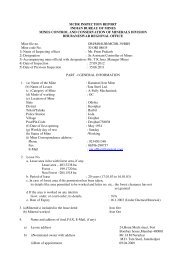Market Survey on Copper - Indian Bureau of Mines
Market Survey on Copper - Indian Bureau of Mines
Market Survey on Copper - Indian Bureau of Mines
You also want an ePaper? Increase the reach of your titles
YUMPU automatically turns print PDFs into web optimized ePapers that Google loves.
mineralisati<strong>on</strong>. <strong>Copper</strong> ore is found in stringers and streaks as breccia filling<br />
and thin veins. The copper ores are predominantly sulphide ores. Chalcopyrite<br />
and pyrite are the principle ores occurring in this deposit. Chalcopyrite<br />
accounts for about 70-80% <strong>of</strong> the total copper ores by volume. Other sulphide<br />
ores reported in this deposit are pentlandite, molybdenite, marcasite, arsenopyrite,<br />
etc. Plate-3.I.<br />
ii) Khetri <strong>Copper</strong> Belt<br />
The Khetri <strong>Copper</strong> Belt extends over a length <strong>of</strong> 80 km from Singhana<br />
to Raghunathgarh in Jhunjhunu district <strong>of</strong> Rajasthan. The host rock for copper<br />
mineralisati<strong>on</strong> in this area comprises metamorphites <strong>of</strong> sedimentary origin, such<br />
as phyllites, quartzites schists, etc. Intrusi<strong>on</strong>s <strong>of</strong> granite, pegmatites and quartz<br />
veins are reported in this country rocks. The ec<strong>on</strong>omic deposits <strong>of</strong> copper occur<br />
at Madhan – Kudan, Kolihan and Chandmari. The copper minerals found in<br />
this belt are sulphides predominantly pyrrhotite, chalcopyrite and pyrite.<br />
Cubanite is also reported at places. Plate-3.II.<br />
iii) Malanjkhand <strong>Copper</strong> Belt<br />
This deposit is situated <strong>on</strong> Malanjkhand hill which is raised above the<br />
surrounding terrain which forms a part <strong>of</strong> Baihar plateau in Balaghat<br />
district, Madhya Pradesh. There are six peaks with intervening saddles and<br />
form an arcute chain <strong>of</strong> about 2.6 km length. The rocks occurring in this area<br />
are classified into broad categories, the older granite rocks and younger<br />
sedimentary rocks <strong>of</strong> Chilpi Ghat series. The bulk <strong>of</strong> mineralisati<strong>on</strong> is reported<br />
to have been c<strong>on</strong>fined to the quartz veins and reefs. The younger sedimentary<br />
rocks are lying uncomfortably over the granitic rocks. The older granitic rocks<br />
are covered by soil with outcrops exposed being traversed by quartz reefs, veins<br />
and veinlets and are highly sheared, fractured and brecciated. Bulk <strong>of</strong> the<br />
sulphide mineralisati<strong>on</strong> is present in this z<strong>on</strong>e as fracture filling in these quartz<br />
reefs and veins. Small amounts <strong>of</strong> copper also occur as disseminati<strong>on</strong>s in the<br />
quartz bands in granitic rocks. Plate-3.III.<br />
The major copper minerals occurring in this deposit are sulphides<br />
namely chalcopyrite, pyrite, covellite, bornite and chalcocite. The oxide ore<br />
occurring in this deposit is cuprite. Native copper and hydroxide ores such as<br />
malachite and azurite are also occasi<strong>on</strong>ally reported.<br />
iv) Agnigundla <strong>Copper</strong> Belt<br />
This deposit is located in the Guntur district <strong>of</strong> Andhra Pradesh. It is<br />
situated near Vinuk<strong>on</strong>da in the north-east corner <strong>of</strong> Cuddappah basin. A part <strong>of</strong><br />
this deposit is also extended in Prakasam district. Bandalmottu and Dhuk<strong>on</strong>da<br />
deposits in Guntur district and Nallak<strong>on</strong>da in Prakasam district are well known.<br />
The host rock in this deposit is coarse grained calcareous quartzite and dolomite<br />
<strong>of</strong> cuddappah super-group. This deposit is divided into 3 blocks, namely:<br />
Bandalmottu lead-copper deposit, Nallak<strong>on</strong>da copper deposit and Dhuk<strong>on</strong>da<br />
copper-lead deposit. The copper mineralisati<strong>on</strong> is c<strong>on</strong>fined to quartzite which<br />
is mainly in the form <strong>of</strong> disseminati<strong>on</strong>s. The deposits were originally<br />
syngenetic but subsequently remobilised and localised in favourable structural<br />
29
















